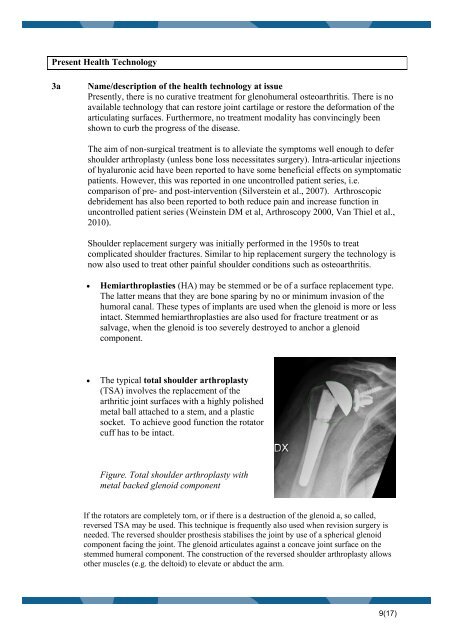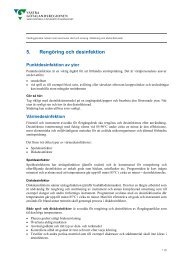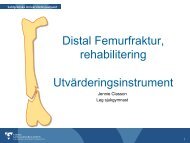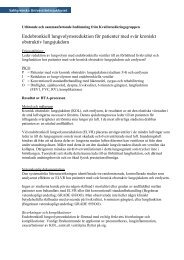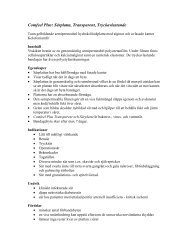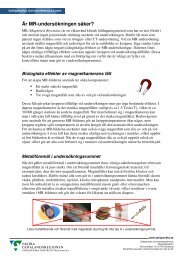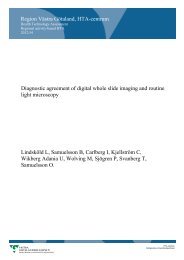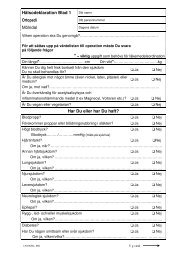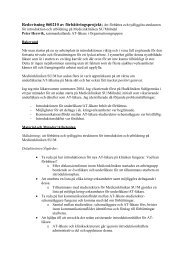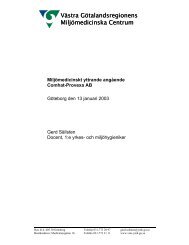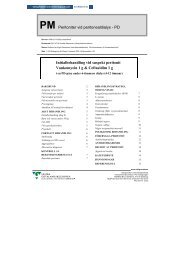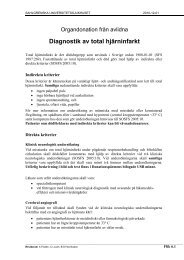HTA - Sahlgrenska Universitetssjukhuset
HTA - Sahlgrenska Universitetssjukhuset
HTA - Sahlgrenska Universitetssjukhuset
You also want an ePaper? Increase the reach of your titles
YUMPU automatically turns print PDFs into web optimized ePapers that Google loves.
Present Health Technology<br />
3a Name/description of the health technology at issue<br />
Presently, there is no curative treatment for glenohumeral osteoarthritis. There is no<br />
available technology that can restore joint cartilage or restore the deformation of the<br />
articulating surfaces. Furthermore, no treatment modality has convincingly been<br />
shown to curb the progress of the disease.<br />
The aim of non-surgical treatment is to alleviate the symptoms well enough to defer<br />
shoulder arthroplasty (unless bone loss necessitates surgery). Intra-articular injections<br />
of hyaluronic acid have been reported to have some beneficial effects on symptomatic<br />
patients. However, this was reported in one uncontrolled patient series, i.e.<br />
comparison of pre- and post-intervention (Silverstein et al., 2007). Arthroscopic<br />
debridement has also been reported to both reduce pain and increase function in<br />
uncontrolled patient series (Weinstein DM et al, Arthroscopy 2000, Van Thiel et al.,<br />
2010).<br />
Shoulder replacement surgery was initially performed in the 1950s to treat<br />
complicated shoulder fractures. Similar to hip replacement surgery the technology is<br />
now also used to treat other painful shoulder conditions such as osteoarthritis.<br />
• Hemiarthroplasties (HA) may be stemmed or be of a surface replacement type.<br />
The latter means that they are bone sparing by no or minimum invasion of the<br />
humoral canal. These types of implants are used when the glenoid is more or less<br />
intact. Stemmed hemiarthroplasties are also used for fracture treatment or as<br />
salvage, when the glenoid is too severely destroyed to anchor a glenoid<br />
component.<br />
• The typical total shoulder arthroplasty<br />
(TSA) involves the replacement of the<br />
arthritic joint surfaces with a highly polished<br />
metal ball attached to a stem, and a plastic<br />
socket. To achieve good function the rotator<br />
cuff has to be intact.<br />
Figure. Total shoulder arthroplasty with<br />
metal backed glenoid component<br />
If the rotators are completely torn, or if there is a destruction of the glenoid a, so called,<br />
reversed TSA may be used. This technique is frequently also used when revision surgery is<br />
needed. The reversed shoulder prosthesis stabilises the joint by use of a spherical glenoid<br />
component facing the joint. The glenoid articulates against a concave joint surface on the<br />
stemmed humeral component. The construction of the reversed shoulder arthroplasty allows<br />
other muscles (e.g. the deltoid) to elevate or abduct the arm.<br />
9(17)


